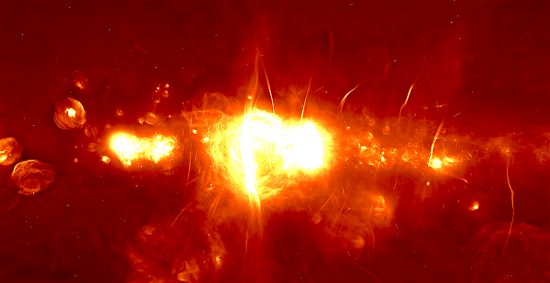
Sep 17, 2019
Galaxies exhibit electric circuits.
“A broad and ample road, whose dust is gold,
And pavement stars—as starts to thee appear
Soon in the galaxy, that milky way
Which nightly as a circling zone thou seest
Powder’d with stars.”
― John Milton
Astronomers cannot see stars (or galaxies) inside dusty environments. The only way to view most structures in the Milky Way is to look at them with infrared light. Giant, filamentary clouds near the galactic center are studied using that technique, since interstellar matter glows at long wavelengths. According to Electric Universe theory, galactic evolution occurs as large-scale plasma discharges form coherent filaments that are influenced by electromagnetism.
When plasma moves through a cloud of dust and gas, the cloud becomes ionized, initiating an electric field and the flow of electric charge. Electricity moving through any substance forms magnetic fields that tend to align and constrict the current flow. Those fields create what are known as Birkeland currents.
Talking about plasma is common among astronomers, but they do so in ways that make its electrical nature to be of little import. Solar “wind”, a “rain” of charged particles, “clouds of ionized gas”: such terms merely convey plasma’s inertial aspects, reducing it to nothing more than hot gas and dust. Since astrophysicists believe that electricity is not a factor when dealing with objects in space, the fact that plasma can act with forces 39 orders of magnitude greater then gravity is ignored.
An electric discharge in plasma creates a magnetic sheath along its axis. When there is sufficient charge flowing through the circuit, the discharge causes the sheath to glow, sometimes creating a number of other sheaths. The sheaths are called “double layers”.
Double layers form when positive charges build up in one region of a plasma cloud and negative charges build up nearby. A powerful electric field appears between the two regions, which accelerates charged particles. The electric charges spiral in the magnetic fields, emitting radio frequencies, X-rays, extreme ultraviolet, and sometimes gamma rays.
Large magnetic fields have been detected in the Milky Way, and those fields indicate that Birkeland currents thread through them. The current-induced magnetic forces pull the currents into filaments, twist the filaments around each other, and then “pinch” the galactic plasma until the internal pressure balances the magnetic constriction. Stars will form like beads along a galactic wire, that wire being a Birkeland current filament.
Stephen Smith
The Thunderbolts Picture of the Day is generously supported by the Mainwaring Archive Foundation.












